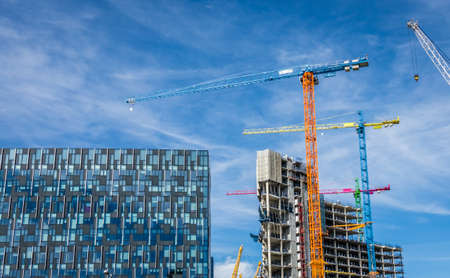Introduction to Urban Regeneration in the UK
Urban regeneration has long been a central pillar of development policy across the United Kingdom, shaping not only the physical environment but also the socio-economic fabric of cities and towns. From the post-industrial transformation of Manchester’s city centre to the revitalisation of London’s Docklands, the history of urban regeneration in the UK reflects a legacy of adapting to changing economic realities and evolving community needs. Today, regeneration projects remain crucial as the country faces contemporary challenges such as housing shortages, regional inequality, and the need for sustainable growth. Current government strategies prioritise brownfield redevelopment, placemaking, and levelling up regional economies, with significant funding directed towards transforming underused or derelict areas into vibrant, mixed-use communities. The combination of public-private partnerships, innovation in construction methods, and a renewed focus on inclusive growth positions urban regeneration at the heart of future urban development opportunities throughout the UK.
2. Key Drivers of UK Regeneration Projects
Urban regeneration in the UK is shaped by a complex interplay of critical factors that collectively determine the trajectory and success of development initiatives. Understanding these drivers is essential for identifying investment opportunities, aligning with policy priorities, and achieving long-term project viability. Below, we analyse the four primary drivers: policy frameworks, economic trends, sustainability imperatives, and demographic shifts.
Policy Frameworks and Government Initiatives
The UK government plays a pivotal role in guiding urban regeneration through targeted policies and funding streams. Programmes such as the Levelling Up Fund, Towns Fund, and support for Freeports are designed to stimulate regional growth and address socioeconomic disparities. Strategic planning guidance from local authorities further shapes land use, infrastructure investment, and housing delivery across cities and towns.
Economic Trends Influencing Investment Decisions
Macroeconomic conditions such as interest rates, inflationary pressures, and public sector borrowing costs impact regeneration feasibility. The resilience of the UK property market post-Brexit and in the wake of COVID-19 has also recalibrated investor expectations. Regeneration schemes are increasingly evaluated not only on immediate returns but also on their ability to catalyse job creation, diversify local economies, and enhance long-term asset values.
Sustainability Demands and Environmental Standards
The push towards net zero targets underpins both public and private sector approaches to regeneration. There is a growing emphasis on sustainable construction methods, renewable energy integration, biodiversity net gain, and low-carbon transport options. Compliance with Building Regulations Part L (energy efficiency) and BREEAM standards is now often a prerequisite for planning consent.
Key Sustainability Considerations in Urban Regeneration
| Factor | Description |
|---|---|
| Energy Efficiency | Adoption of high-performance building materials and systems to reduce operational emissions |
| Green Infrastructure | Integration of parks, green roofs, and urban planting to improve air quality and wellbeing |
| Sustainable Mobility | Provision of cycling facilities, EV charging points, and pedestrian-friendly layouts |
Shifting Demographics and Urban Lifestyles
The demographic profile of UK cities is evolving rapidly due to internal migration patterns, international arrivals, and an ageing population. Demand for diverse housing types—including build-to-rent, affordable homes, co-living spaces—and mixed-use developments reflects changing household structures and lifestyle preferences. Successful regeneration projects therefore incorporate flexible space design, accessible amenities, and robust community engagement strategies.
Summary Table: Critical Factors Driving UK Regeneration
| Driver | Impact on Urban Development |
|---|---|
| Policy Frameworks | Guides investment direction; unlocks funding; sets planning standards |
| Economic Trends | Influences project feasibility; shapes risk-return profiles for investors |
| Sustainability Demands | Makes compliance essential; increases long-term value; future-proofs assets |
| Demographic Shifts | Alters demand patterns; drives design innovation; supports inclusive growth |
Taken together, these key drivers offer a dynamic context in which urban regeneration projects must operate. Stakeholders who proactively align their strategies with these factors will be best positioned to seize emerging opportunities within the UK’s evolving urban landscape.

3. Emerging Opportunities for Investors and Developers
The evolving landscape of UK urban regeneration is presenting a wealth of opportunities for both investors and developers. As local authorities and private stakeholders collaborate to rejuvenate cities, certain sectors and regions are emerging as particularly promising. Understanding where these growth areas lie is essential for those looking to capitalise on the next wave of urban transformation.
Mixed-Use Developments: Redefining Urban Living
One of the most notable trends is the rise of mixed-use developments, which seamlessly blend residential, commercial, and leisure spaces within a single masterplan. These projects not only address changing lifestyle preferences but also create vibrant communities that drive sustained economic activity. Cities such as Manchester, Birmingham, and Leeds are leading the way, with large-scale schemes attracting significant institutional investment due to their resilience and long-term value potential.
Build-to-Rent Schemes: Meeting Modern Housing Demands
The build-to-rent (BTR) sector has gained considerable traction across the UK, responding to increased demand for high-quality, professionally managed rental accommodation. With shifting demographics and greater mobility among young professionals, BTR schemes are thriving in urban centres like London, Bristol, and Glasgow. For investors, these projects offer stable income streams and reduced volatility compared to traditional buy-to-let models.
Revitalisation of High Streets: Reinventing Local Economies
The transformation of high streets remains a key focus area as towns seek to adapt to changing retail habits and create more sustainable local economies. Creative repurposing of vacant retail units into co-working spaces, cultural venues, or affordable housing is breathing new life into previously declining areas. Regions such as the North East and Midlands are seeing success stories where regeneration has stimulated job creation and fostered community engagement.
Regional Hotspots for Growth
While London continues to attract global attention, regional cities are increasingly recognised as hotspots for regeneration-driven growth. Areas with strong transport links, supportive local authorities, and proactive business communities—such as Liverpool’s Knowledge Quarter or Cardiff’s Central Square—are drawing investor interest. Strategic analysis suggests these regions offer compelling risk-adjusted returns over the medium term.
Strategic Considerations for Stakeholders
For those looking to participate in UK urban regeneration projects, a targeted approach is essential. Evaluating each sector’s fundamentals—tenant demand, regulatory environment, and long-term socio-economic trends—will be key in identifying projects with the greatest upside potential. With the right market intelligence and partnership strategies, both investors and developers can position themselves at the forefront of the UK’s urban renaissance.
4. Sustainable and Inclusive Urban Design
The future of urban development in the UK hinges on the adoption of sustainable and inclusive design practices. As regeneration projects become more prominent, developers and policymakers are recognising that truly successful urban renewal must address environmental, social, and cultural dimensions specific to British communities.
Sustainable Building Practices
Incorporating sustainability into urban regeneration is no longer optional—it is a fundamental expectation across the UK. This involves using energy-efficient materials, reducing carbon footprints, and prioritising green infrastructure such as parks, communal gardens, and renewable energy sources. Local authorities increasingly set ambitious targets for net zero developments, pushing for innovative solutions in both new builds and retrofits.
| Sustainability Feature | Benefits |
|---|---|
| Energy-Efficient Construction | Reduces operational costs and emissions |
| Green Spaces | Improves air quality, enhances wellbeing |
| Rainwater Harvesting | Mitigates flood risks, conserves water resources |
Community Engagement
A core tenet of modern regeneration is meaningful community engagement. Involving local residents from the outset ensures that projects reflect the aspirations and concerns of those who will live and work there. British cities and towns exhibit diverse identities—engagement strategies must therefore be tailored to local histories, cultures, and priorities. Transparent consultations foster trust, encourage active participation, and ultimately lead to places that residents feel proud to call home.
Inclusive Design for Distinct Needs
Inclusive urban design goes beyond accessibility compliance; it means creating environments where everyone can thrive, regardless of age, ability, or background. This might entail step-free access to public transport in London boroughs or supporting intergenerational living arrangements in Northern towns. Recognising regional distinctions ensures that regeneration schemes deliver genuine value to their communities rather than imposing generic solutions.
Key Principles of Inclusive Urban Design in the UK
| Principle | Description |
|---|---|
| Diversity of Housing Types | Cater to families, singles, elderly, and disabled residents |
| Public Realm Accessibility | Design spaces usable by all community members |
| Cultural Sensitivity | Reflect local heritage and traditions in design choices |
Looking Forward: Embedding Sustainability and Inclusion
The most forward-thinking UK regeneration projects are those that embed sustainability and inclusion at every stage—from initial planning through to long-term stewardship. By championing these principles, developers and stakeholders can unlock economic opportunities while ensuring vibrant, resilient futures for Britain’s cities and towns.
5. Challenges and Considerations in UK Regeneration
The future of urban development in the UK is closely intertwined with the ability to overcome a series of complex challenges inherent in regeneration projects. While the opportunities for transformation are significant, stakeholders must navigate a landscape shaped by regulatory, financial, and social considerations.
Navigating Planning Regulations
One of the primary obstacles in UK regeneration projects lies in the complexity of planning regulations. The planning system is designed to balance economic growth with heritage preservation, environmental protection, and community needs. Securing planning permission often requires extensive consultation, detailed impact assessments, and compliance with evolving national and local policies. Delays can arise from objections, appeals, or changes in policy direction, making it essential for developers to engage proactively with local authorities and planning consultants early in the process.
Securing Sustainable Funding
Accessing adequate funding remains a perennial challenge for regeneration schemes. Traditional sources such as public grants and private sector investment are increasingly supplemented by innovative financing models, including public-private partnerships (PPPs) and social impact bonds. However, uncertainty over project returns, shifting government priorities, and fluctuating market conditions can complicate fundraising efforts. Successful projects typically demonstrate robust business cases, clear alignment with strategic local objectives, and strong risk mitigation strategies to attract sustained financial backing.
Addressing Local Community Concerns
Engagement with local communities is critical to the success of any regeneration initiative. Residents may express concerns about displacement, gentrification, loss of local identity, or insufficient affordable housing provision. Transparent communication and genuine collaboration are key: best practice includes early-stage consultation, inclusion of community representatives in decision-making processes, and tailored solutions that reflect local priorities. By fostering trust and demonstrating tangible benefits for existing residents, developers can mitigate opposition and build long-term support.
Strategic Considerations Moving Forward
For investors and developers eyeing opportunities in UK regeneration, it is imperative to adopt a holistic approach that anticipates regulatory hurdles, secures diverse funding streams, and prioritises inclusive engagement with local communities. Navigating these challenges not only reduces risk but also enhances the social value and resilience of regeneration outcomes—an essential factor for sustainable urban growth in the years ahead.
6. Strategic Recommendations for Stakeholders
Actionable Guidance for Maximising Value in Regeneration
As the landscape of urban development evolves across the UK, stakeholders must adopt proactive and collaborative strategies to unlock the full potential of regeneration projects. This approach not only maximises financial returns but also ensures alignment with broader social and economic objectives, such as community well-being, sustainability, and inclusive growth.
For Property Professionals: Innovate and Collaborate
Property professionals are encouraged to embrace innovative design solutions that cater to changing lifestyles and work patterns. Prioritising mixed-use developments, integrating green infrastructure, and adopting modern construction methods—such as modular building—can enhance project appeal while reducing environmental impact. Early engagement with local communities and authorities is essential for identifying needs, securing buy-in, and de-risking planning processes.
For Local Authorities: Foster Partnerships and Streamline Processes
Councils should prioritise the creation of clear, long-term regeneration frameworks that provide certainty for investors and developers. Establishing public-private partnerships can help leverage private capital and expertise while ensuring that projects deliver local benefits. Streamlining planning approval processes, offering incentives for sustainable features, and championing affordable housing quotas will help accelerate delivery and address pressing local challenges.
For Investors: Align Capital with Social Value
Investors should look beyond traditional financial metrics by incorporating Environmental, Social & Governance (ESG) criteria into their decision-making. Supporting schemes that create jobs, improve connectivity, and revitalise underutilised assets can yield resilient returns while meeting growing demand for responsible investment. Engaging with local partners and monitoring project impact will further enhance long-term value.
Integrating Technology and Data-Driven Insights
All stakeholders are advised to harness emerging technologies—from digital twinning to smart sensors—to optimise asset performance, inform urban planning decisions, and monitor real-time outcomes. Leveraging data analytics not only improves efficiency but also enables responsive management of resources in line with community needs.
Championing Inclusive Regeneration
A commitment to inclusivity should be embedded at every stage of project delivery. This includes engaging diverse community groups, supporting skills development programmes, and ensuring accessibility in both design and operation. By prioritising long-term social value alongside commercial success, stakeholders can future-proof UK regeneration projects against shifting demographic trends and policy expectations.


